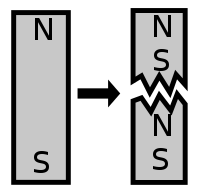Magnetic monopole

A magnetic monopole is a hypothetical particle in particle physics that is a magnet with only one magnetic pole (a north pole without a south pole or the other way around).[1][2] Scientists are interested in this, as they are predicted in several particle theories, such as grand unified and superstring.[3][4] Magnetism in normal bar magnets and electromagnets does not come from magnetic monopoles. There is not enough evidence to even be sure that magnetic monopoles exist in this universe.
References[change | change source]
- ↑ Hooper, Dan (2009). Dark Cosmos: In Search of Our Universe's Missing Mass and Energy. Harper Collins. p. 192. ISBN 978-0-06-197686-5.
- ↑ Particle Data Group summary of magnetic monopole search
- ↑ Wen, Xiao-Gang; Witten, Edward, Electric and magnetic charges in superstring models,Nuclear Physics B, Volume 261, p. 651-677
- ↑ S. Coleman, The Magnetic Monopole 50 years Later, reprinted in Aspects of Symmetry
